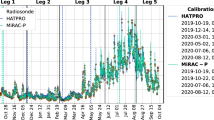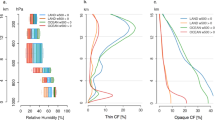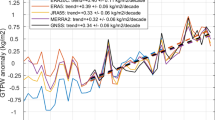Abstract
THE early pioneering work of Dobson, Brewer and Cwilong with frost point hygrometers indicated that over South England the water-vapour content of the stratosphere between 12 and 15 km is extremely small in all seasons, being about 2 mg/kg (frost point temperature being about − 80°). Subsequent measurements of humidity between the same levels over a geographical region extending from Norway to equatorial Africa revealed the interesting fact that in all seasons and in most of the locations the moisture content of the lower stratosphere is very small. On the basis of such observations, which led to the concept of a uniformly dry stratosphere, Dobson et al.1 postulated the existence of a meridional circulation in the stratosphere involving the poleward movement of very cold saturated air near the equatorial tropopause and its descent over high latitudes. This theory has been amplified further by Ramanathan2 and Murgatroyd and Singleton3. On the other hand, a large number of observations made over the North American continent and Greenland during 1959 and 1960 using automatically registering frost point hygrometers indicated a very wide range of frost point temperatures from − 67° to − 80° C (refs. 4, 5). Similar observations made over Japan indicate that on many occasions the water-vapour mixing ratio increases with height in the stratosphere6. Rohrbough7, using a balloon-borne sampling system, has recently reported high humidity mixing ratio of 320 mg/kg at a height of 30 km over the United States, this height being a record for the determination of humidity. These recent observational results, which indicate a rather complex distribution of water-vapour, suggest that the earlier concept of a uniformly dry stratosphere needs re-examination.
This is a preview of subscription content, access via your institution
Access options
Subscribe to this journal
Receive 51 print issues and online access
$199.00 per year
only $3.90 per issue
Buy this article
- Purchase on Springer Link
- Instant access to full article PDF
Prices may be subject to local taxes which are calculated during checkout
Similar content being viewed by others
References
Dobson, G. M. B., et al., Proc. Roy. Soc., A, 185, 470 (1946).
Ramanathan, K. R., Ind. J. Met. Geoph., 12, 391 (1961).
Murgatroyd et al., Quart. J. Roy. Met. Soc., 87, 125 (1961).
Gutnick, M., J. Geophys. Res., 66, 9 2867 (1961).
Mastenbrook, N. J., and Dinger, J. E., J. Geophys. Res., 66, 5, 1437 (1961).
Hayashi, E., J. Aerol. Obsy. Tateno. Japan, 7, 91 (1962).
Rohrbough, S. F., Science, 137, 599 (1962).
de Turville, C. M., Nature, 190, 156 (1961).
Frith, R., Nature, 191, 1182 (1961).
Warnecke, G., Berliner Wetterkarte (Berlin, 1961).
Author information
Authors and Affiliations
Rights and permissions
About this article
Cite this article
RANGARAJAN, S. A Secondary Source of Water Vapour in the Upper Atmosphere. Nature 197, 1099–1101 (1963). https://doi.org/10.1038/1971099a0
Issue Date:
DOI: https://doi.org/10.1038/1971099a0
Comments
By submitting a comment you agree to abide by our Terms and Community Guidelines. If you find something abusive or that does not comply with our terms or guidelines please flag it as inappropriate.



